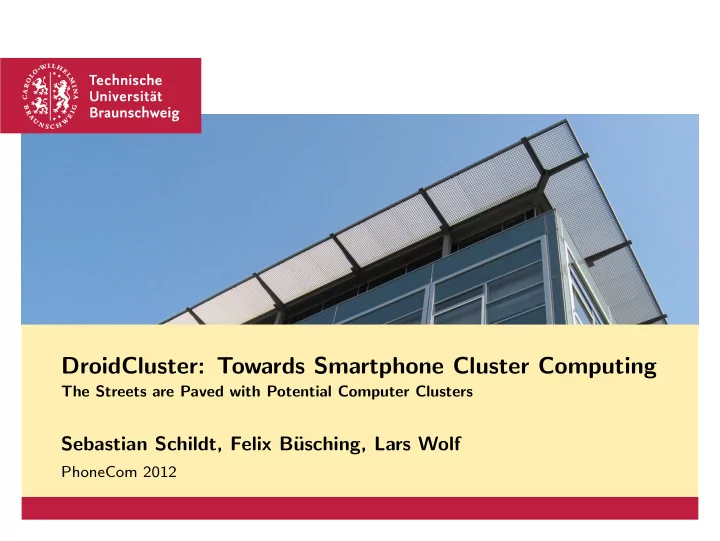

DroidCluster: Towards Smartphone Cluster Computing The Streets are Paved with Potential Computer Clusters Sebastian Schildt, Felix B¨ usching, Lars Wolf PhoneCom 2012
Introduction The Cluster Implications Opportunities Once upon a time... In the beginning of 2011 we bought 6 medium class Android Smartphones for a programming lab. LG P500, Android 2.2, 600 MHz Qualcomm MSM7227, 512 MiB RAM Sebastian Schildt | DroidCluster: Towards Smartphone Cluster Computing | 2
Introduction The Cluster Implications Opportunities The idea... We should build a cluster out of it! Sounds like a reasonable idea! Sebastian Schildt | DroidCluster: Towards Smartphone Cluster Computing | 3
Introduction The Cluster Implications Opportunities Architecture Wireless Access Point USB-Connection (a) WiFi-Connection (b) Android #1 Control PC MPI Master 2 3 4 5 6 MPI Slaves Sebastian Schildt | DroidCluster: Towards Smartphone Cluster Computing | 4
Introduction The Cluster Implications Opportunities Software Full ARM Debian installation alongside the Android OS (chroot) MPI-based Linpack benchmark Connectivity through WiFi or USB reverse-tethering Control PC only used for controlling and monitoring the phones, not involved in calculation Sebastian Schildt | DroidCluster: Towards Smartphone Cluster Computing | 5
Introduction The Cluster Implications Opportunities Results 40 35 USB-Bridge WLAN 30 29.04 ideal 26.15 25 23.22 22.01 19.48 20 18.02 15.05 15 14.16 10.04 10 MFLOPS 10.15 5.81 5 Nodes 0 0 0 0 1 2 3 4 5 6 Sebastian Schildt | DroidCluster: Towards Smartphone Cluster Computing | 6
Introduction The Cluster Implications Opportunities Our Cluster No specialized mobile application, but standard Debian distribution and standard libraries and tools → would not have been possible on a phone a few years ago Running alongside the normal phone applications Closely-coupled: Standard MPI, but over slow communication links → still scales reasonably Absolute performance not that impressive Sebastian Schildt | DroidCluster: Towards Smartphone Cluster Computing | 7
Introduction The Cluster Implications Opportunities SoC Evolution: Measured Performance under Android ARM Core MFLOPS Android System CPU MHz Huawei U8120 Qualcomm MSM7225 528 ARM11 2.3.7 3.7 LG P500 Qualcomm MSM7227 600 ARM11 2.2 4.0 HTC Legend Qualcomm MSM7227 600 ARM11 2.3.7 7.5 Samsung Galaxy S Samsung Exynos 3110 1000 Cortex A8 2.3.7 17.7 HTC Nexus One Qualcomm QSD 8250 1000 Scorpion 4.0.3 31.0 Medion Lifetab P9514 Nvidia Tegra 2 2x1000 Cortex A9 3.2 54.4 Samsung Galaxy Nexus Texas Instruments OMAP 4460 2x1200 Cortex A9 4.0.2 75.0 Performance drivers: Transition to multicore, out-of-order architectures, (better) FPU+SIMD units Next big thing: OpenCL capable mobile GPUs for GPGPU offloading Sebastian Schildt | DroidCluster: Towards Smartphone Cluster Computing | 8
Introduction The Cluster Implications Opportunities Opportunities Chances for ubiquitous mobile applications, crowd sensing platforms, data distribution networks based on mobile phones. You can put computation back from the backend into the users device form Ad-Hoc groups to cooperatively solve a problem consider the best tradeoff between closely-coupled cooperation (e.g. MPI) and loosely-coupled cooperation (BOINC, “seti@home”) “If I am collecting temperature and pressure data, why shouldn’t I also calculate the weather report?” Sebastian Schildt | DroidCluster: Towards Smartphone Cluster Computing | 9
Introduction The Cluster Implications Opportunities An example... Employee Charges Phone - Fired for Stealing Electricity! Sebastian Schildt | DroidCluster: Towards Smartphone Cluster Computing | 10
Introduction The Cluster Implications Opportunities Proposal: distcc for Android Distribute compilation of larger projects over different nodes 1. During the day employees put their phone into a USB port of their computer for charging 2. Phone registers at the company Phone-Cloud control server 3. Phone will be automatically provisioned with the necessary compilation environment and registered to the distcc system Benefits Users can charge phones without risking being fired Bring-Your-Own-Device: Companies can leverage hardware already paid for by their employees Sebastian Schildt | DroidCluster: Towards Smartphone Cluster Computing | 11
Introduction The Cluster Implications Opportunities Conclusions Many mobile phones today are faster than desktop computers from 10 years ago The architectural evolution of mobile SoCs follows those of traditional desktop and server CPUs But SoCs are catching up: Programmable GPUs, SIMD units, ... This gives some room for innovative research applications Levering existing smartphones’ processing power is environmentally sustainable, as their SoCs are quite energy efficient It is necessary to find a trade-off between tapping the computing power and draining the battery Thank you! Sebastian Schildt | DroidCluster: Towards Smartphone Cluster Computing | 12
Recommend
More recommend